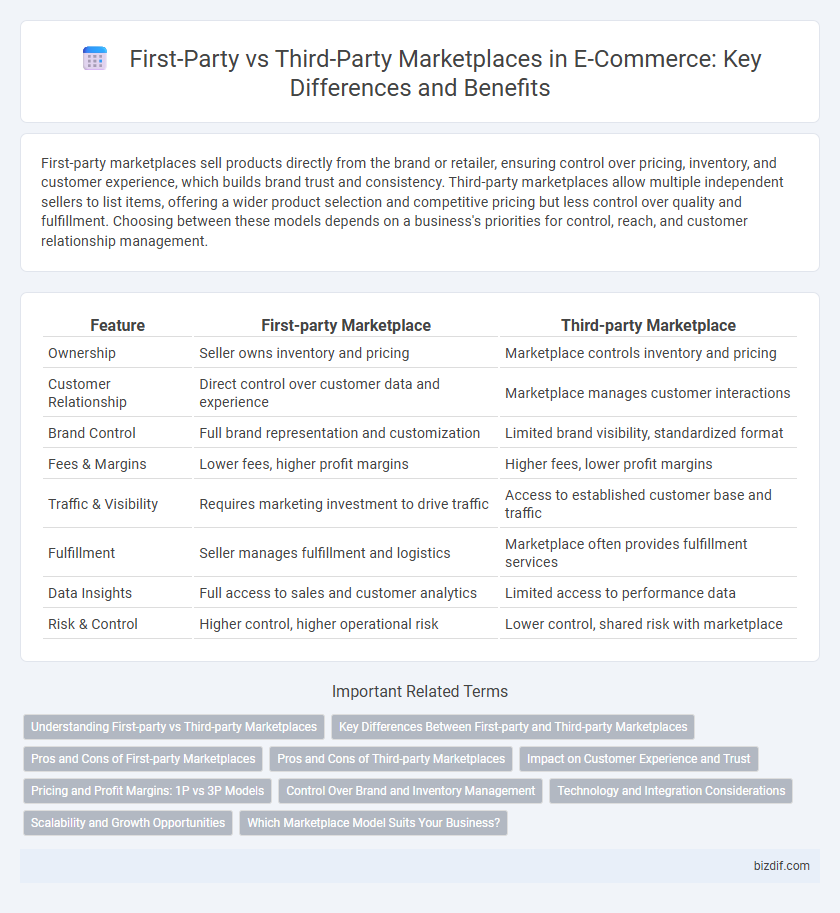First-party marketplaces sell products directly from the brand or retailer, ensuring control over pricing, inventory, and customer experience, which builds brand trust and consistency. Third-party marketplaces allow multiple independent sellers to list items, offering a wider product selection and competitive pricing but less control over quality and fulfillment. Choosing between these models depends on a business's priorities for control, reach, and customer relationship management.
Table of Comparison
| Feature | First-party Marketplace | Third-party Marketplace |
|---|---|---|
| Ownership | Seller owns inventory and pricing | Marketplace controls inventory and pricing |
| Customer Relationship | Direct control over customer data and experience | Marketplace manages customer interactions |
| Brand Control | Full brand representation and customization | Limited brand visibility, standardized format |
| Fees & Margins | Lower fees, higher profit margins | Higher fees, lower profit margins |
| Traffic & Visibility | Requires marketing investment to drive traffic | Access to established customer base and traffic |
| Fulfillment | Seller manages fulfillment and logistics | Marketplace often provides fulfillment services |
| Data Insights | Full access to sales and customer analytics | Limited access to performance data |
| Risk & Control | Higher control, higher operational risk | Lower control, shared risk with marketplace |
Understanding First-party vs Third-party Marketplaces
First-party marketplaces involve brands or manufacturers selling products directly to consumers through their own platforms, ensuring control over pricing, branding, and customer data. Third-party marketplaces host multiple independent sellers, offering a broader product selection but limited control over pricing and customer interactions. Understanding the differences helps businesses optimize their e-commerce strategy for brand visibility, customer loyalty, and profit margins.
Key Differences Between First-party and Third-party Marketplaces
First-party marketplaces operate as direct sellers, managing inventory, pricing, and customer service, which ensures greater control over product quality and brand experience. Third-party marketplaces provide a platform for independent sellers to list and sell products, offering a diverse product range but less consistency in user experience and fulfillment standards. The key differences lie in control over inventory, customer interaction, and revenue models, with first-party marketplaces often generating revenue through margin and third-party platforms earning via commissions or fees.
Pros and Cons of First-party Marketplaces
First-party marketplaces offer brands greater control over pricing, branding, and customer experience by directly managing inventory and sales channels. They reduce reliance on external sellers, improving profit margins and ensuring product authenticity but require significant investment in logistics and platform management. However, limited product variety compared to third-party marketplaces can restrict consumer choice and market reach.
Pros and Cons of Third-party Marketplaces
Third-party marketplaces offer access to a vast customer base and reduced marketing costs, allowing sellers to scale quickly with minimal infrastructure investment. However, sellers face higher fees, limited brand control, and direct competition with other vendors, which can impact profit margins and customer loyalty. Dependence on the marketplace's policies and algorithms also introduces risks related to account suspension and restricted data access.
Impact on Customer Experience and Trust
First-party marketplaces typically offer a more controlled and consistent shopping experience, enhancing customer trust through verified product quality and reliable customer service. Third-party marketplaces provide a wider product variety but may introduce variability in seller reliability and fulfillment speed, potentially affecting customer satisfaction. Consumer trust is often higher in first-party platforms due to centralized oversight, whereas third-party marketplaces rely heavily on user reviews and ratings to build credibility.
Pricing and Profit Margins: 1P vs 3P Models
First-party (1P) marketplaces purchase products wholesale and set retail prices, often resulting in lower profit margins for sellers due to fixed pricing and platform fees. Third-party (3P) marketplaces enable sellers to control pricing strategies directly, allowing for greater flexibility and potentially higher profit margins by optimizing price points based on market demand. Pricing power and margin optimization in 3P models typically outperform 1P models, where sellers act more like suppliers than independent retailers.
Control Over Brand and Inventory Management
First-party marketplaces provide sellers with greater control over brand representation and inventory management by allowing direct interaction with consumers and centralized inventory tracking. Third-party marketplaces often limit brand customization options and require sellers to comply with platform policies, which can restrict control over product presentation and stock levels. Efficient inventory management on first-party platforms reduces stockouts and overselling, enhancing customer experience and brand reputation.
Technology and Integration Considerations
First-party marketplaces leverage proprietary technology platforms that provide seamless inventory synchronization, direct access to customer data, and integrated payment gateways for enhanced control and customization. Third-party marketplaces rely on external technology providers, requiring robust API integration, data mapping, and compliance with platform standards to ensure smooth order processing and real-time stock updates. Effective integration strategies include middleware solutions, automated workflows, and scalable software architecture to optimize operational efficiency and reduce latency across both marketplace types.
Scalability and Growth Opportunities
First-party marketplaces offer greater control over brand presentation and customer data, enabling tailored marketing strategies that drive scalable growth. Third-party marketplaces provide access to established customer bases and extensive distribution networks, facilitating rapid expansion but with limited control over customer experience. Balancing these platforms allows e-commerce businesses to optimize scalability by leveraging owned data insights and broad market reach simultaneously.
Which Marketplace Model Suits Your Business?
Choosing between a first-party marketplace and a third-party marketplace depends on your business goals, control preferences, and brand positioning. First-party marketplaces allow direct control over inventory and pricing, ideal for brands seeking full data ownership and premium customer experience. Third-party marketplaces offer broader reach with lower upfront costs, suitable for businesses prioritizing rapid market expansion and diverse product offerings.
First-party Marketplace vs Third-party Marketplace Infographic

 bizdif.com
bizdif.com